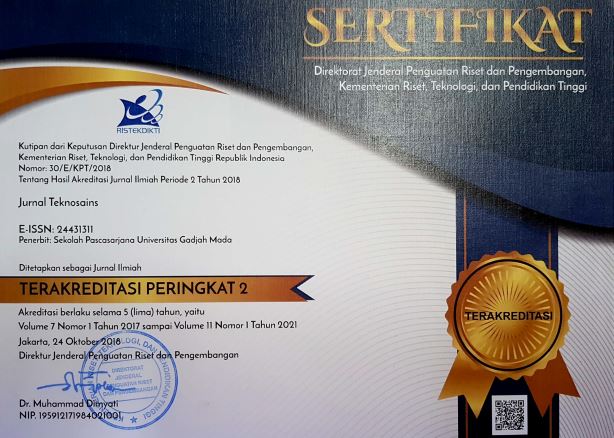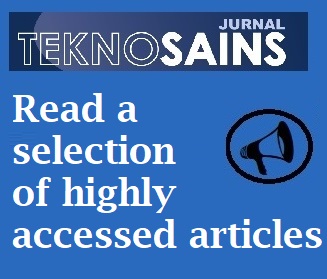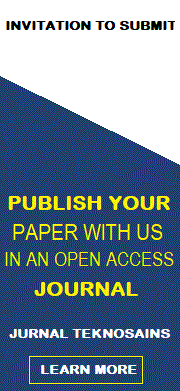Pengaruh Desain Stent pada Jumlah Limfosit dan Trombosit Kelinci (Oryctolagus Cuniculus)
Widowati Siswomihardjo(1*), Dyah Anindya Widyasrini(2), Dinar Arifianto(3), Setyo Budhi(4), Nahar Taufiq(5)
(1) Departemen Ilmu Bahan Kedokteran Gigi, Fakultas Kedokteran Gigi, Universitas Gadjah Mada, Yogyakarta, Indonesia
(2) Departemen Ilmu Bahan Kedokteran Gigi, Fakultas Kedokteran Gigi, Universitas Gadjah Mada, Yogyakarta, Indonesia
(3) Departemen Patologi Klinik, Fakultas Kedokteran Hewan, Universitas Gadjah Mada Yogyakarta, Indonesia
(4) Departemen Ilmu Bedah dan Radiologi, Fakultas Kedokteran Hewan, Universitas Gadjah Mada Yogyakarta, Indonesia
(5) Departemen Kardiologi dan Vaskuler, Fakultas Kedokteran, Universitas Gadjah Mada Yogyakarta, Indonesia
(*) Corresponding Author
Abstract
Percutaneous Coronary Intervention (PCI) is an effective treatment for coronary artery diseases. For the procedure, a stent is put in the coronary arteries. There are a variety of stent materials and designs available on the market. The development of stents continues with the goal to reduce the risk of failure. The design and the ability of the stent as a vascular scaffold are important factors for the success of the stent. The implantation of a stent as a foreign body can lead to inflammation. In general, the inflammation is characterized by an increased number of lymphocytes. Then, platelets play a role in coordinating the occurrence of inflammation and immune response. This study aims to determine the effect of stent design on the number of lymphocytes and platelets as a marker of inflammation. The study was conducted on ten rabbits divided into two treatment groups, namely KP1 (new design stent) and KP2 (commercial stent) by placing a stent on the iliac artery. One hour before stenting, 2 ml of blood was collected in all experimental animals. Then, 2 ml of blood was collected again on the 7th and 28th day after stenting. Data was collected based on the number of lymphocytes and platelets from all experimental animals. Statistical analysis using two-way ANOVA shows no significant difference (p> 0.05) on the number of lymphocytes and platelets between the two groups with different stent designs. It can be concluded that the design of a stent does not show a tendency to cause inflammation.
Keywords
Full Text:
PDFReferences
Ahmed, A.U. 2011. “An overview of inflammation: mechanism and conseuences”. Front. Biol, 6(4): 274–281. Anderson, J. dan Cramer, S. 2015. “Perspectives on the inflammatory, healing, and foreign body responses to biomaterials and medical devices”. Host Response to Biomaterials. Elsevier. Philadelphia. Anderson, J.M. 2013. “Inflammation, wound healing, and the foreign-body response”. Biomaterials Science. Academic Press. Cambridge. Balli M, Taşolar H, Çetin M, Cagliyan CE, Gözükara MY, Yilmaz M, Elbasan Z, dan Cayli M. 2015. “Relationship of platelet indices with acute stent thrombosis in patients with acute coronary syndrome”. Postepy Kardiol Interwencyjnej., 11(3): 224-9. Borhani, S., Hassanajili, S., Ahmadi, T.S.H, dan Rabbani, S. 2018. “Cardiovascular stents: overview, evolution, and next generation”. Prog Biomater. 7(3): 175-205. Cannon, A.L., Hood, L.K., dan Yakubov, J.S. 2010. “Does the metal matter?”. Cardiac Intervention Today. May/June: 41-47 Gasparyan, A.Y., Ayvazyan, L., Mukanova, U., Yessirkepov, M., Kitas, G.D. 2019. “The Platelet-to-lymphocyteratio as an inflammatory marker in rheumatic diseases. Ann Lab Med. 39: 345-357. Gomes, W.J. dan Buffolo, E. 2003. “Coronary stenting and inflammation”. Rev Braz Cir Cardiovasc. 18(4): III-VII. Grewe, P.H., Deneke, T., Machraoui, A., Barmeyer, J., Mu¨ller, K.M. 2000. Acute and Chronic Tissue Response to Coronary Stent Implantation: Pathologic Findings in Human Specimen. JACC Vol. 35 Heleen, M.M, van Bausekom, dan Patrick, W.S. 2010. “Drug-eluting stent endothelium presence or dysfunction”. J Am Coll Cardiol Intv. 3: 76-77. Hermawan, H., Ramdan, D. dan Djuansjah, J. 2011. Metals for Biomedical Applications, Biomedical Engineering - From Theory to Applications. In: Fazel, R (eds.) InTech. http://www.intechopen.com/books/biomedical-engineering-from-theory-toapplications/metals-for biomedicalapplications Kementerian Kesehatan RI. 2013. Riset Kesehatan Dasar. Badan Penelitian dan Pengembangan Kesehatan. Jakarta. Kementerian Kesehatan RI. 2018. Riset Kesehatan Dasar. Badan Penelitian dan Pengembangan Kesehatan. Jakarta. Kolandaivelu, K. dan Rikhtegar,F. 2016. “The systems biocompatibility of coronary stenting”. Intervent Cardiol Clin. 5(2016): 295—306. Kozuh, S., Gojic, M., dan Kosec, L. 2007. “The effect of annealing on properties of AISI 316L base and weld metals”. RMZ – Materials and Geoenvironment. 54:331-344. Levesque, J., Dube, D., dan Fiset, M. 2004. “Materials and properties of coronary stent”. Advanced Materials and Processes. 162(9): 45-48. Mariani, E., Lisignoli, G., Borzi R.M., dan Pulsatelli, L. 2019. “Biomaterials: Foreign bodies or tuners for the immune response?”. Int J Mol Sci. 20(3): 636. Moore, D.M., Zimmermen, K., Smith, S. A. 2015., Hematological Assessment in Pet Rabbits Blood Sample Collection and Blood Cell Identification. Vet Clin Exot Anim 18 (2015) 9–19 Siswomihardjo W., Herliansyah MK., Dinar N. 2017. Biocompatibility of Metal Alloys as Medical Devices. Proceeding of 5th Int Conference on Instrumentation, Communications, Information Technology, and Biomedical Engineering (ICICI-BME), Bandung, Indonesia. IEEE Publication, 10-12. Song, R.B., Xiang, J.Y., dan Hou, D.P. 2011. “Characteristics of mechanical properties and microstructure for 316L austenitic stainless steel”. Journal of Iron and Steel Research, Internatinal. 18(11): 53-59. Teo, W.Z.W., Schalock, P.C. 2017. Metal Hypersensitivity Reactions to Orthopedic Implants. Dermatol Ther. 7:53–64 Thomas, M.K. dan Storey, R.F. 2015. “The role of platelets in inflammation”. Thrombosis and Haemostasis. 114(3): 449-458. Tontowi, A.E., Pratama, I., Hariawan, H., Rinastiti, M., dan Siswomihardjo, W. 2015. “Strength and displacement of open cell design of coronary stent in responding of various inflated pressure”. 4th International Conference on Instrumentation, Communication, Information Technology, and Biomedical Engineering (ICICI-BME). Bandung. 18-21. Walker, C.M. 2015. “How to approach in-stent restenosis”. NCVH 16th Annual Conference. New Orleans
Article Metrics
Refbacks
- There are currently no refbacks.
Copyright (c) 2019 Widowati Siswomihardjo, dkk.

This work is licensed under a Creative Commons Attribution-ShareAlike 4.0 International License.
Copyright © 2024 Jurnal Teknosains Submit an Article Tracking Your Submission
Editorial Policies Publishing System Copyright Notice Site Map Journal History Visitor Statistics Abstracting & Indexing









